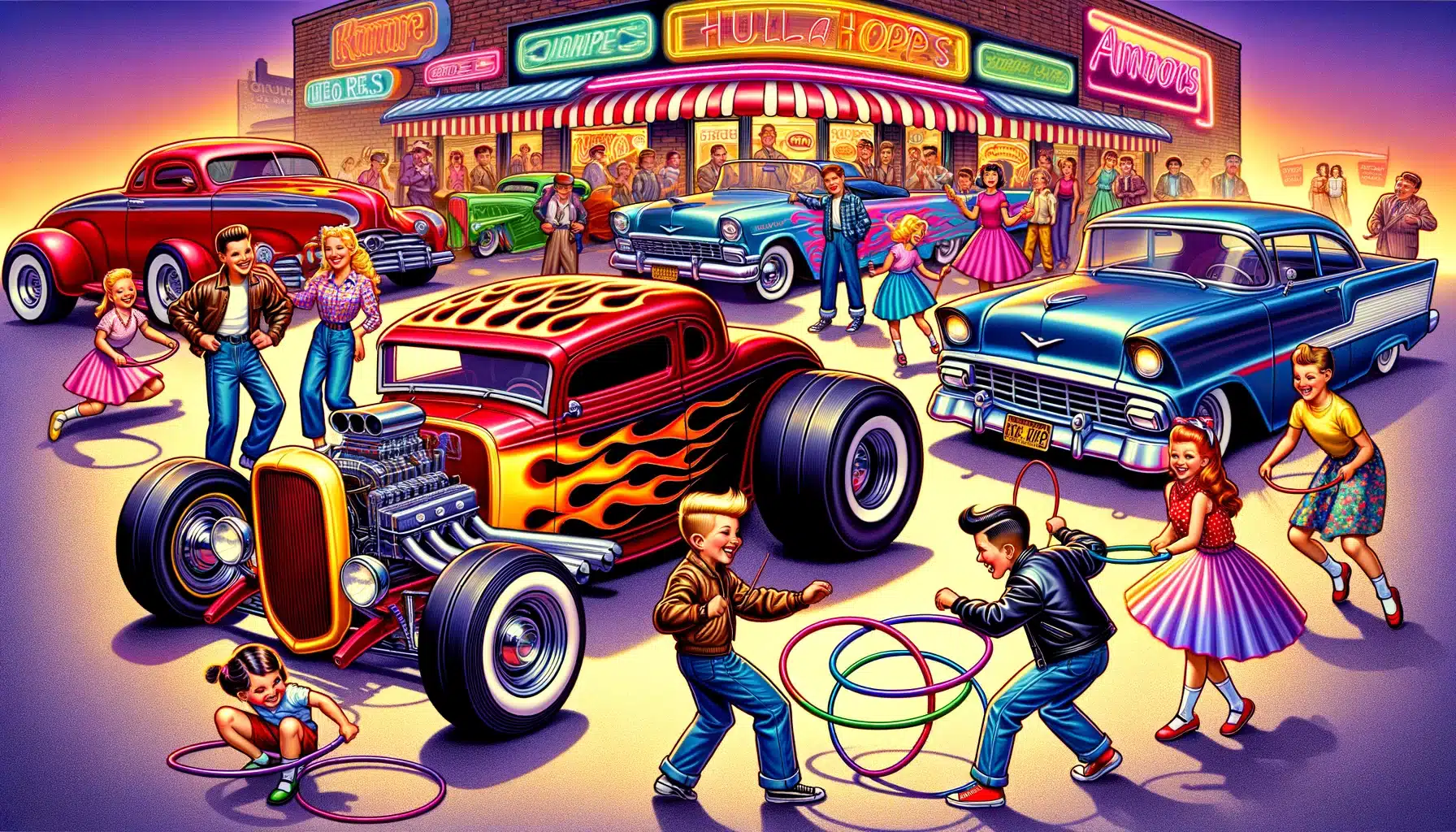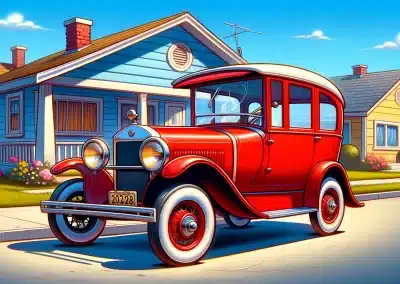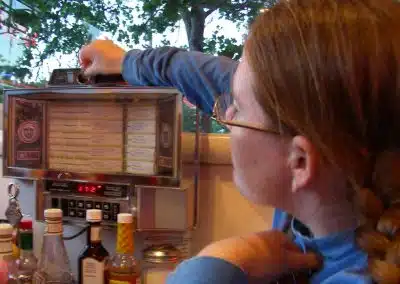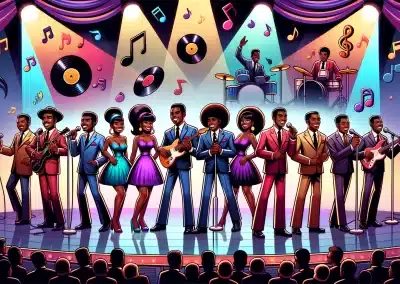Hot Rods and Hula Hoops: The 1950s saw an explosion of popular fads and gadgets that captivated Americans of all ages. Hot rods and Hula Hoops became emblematic of a post-war culture keen on embracing leisure, novelty, and the spirit of innovation. As economic prosperity flourished, so too did the appetite for new forms of entertainment and expression. The era’s quintessential pastimes mirrored a society’s enthusiasm for the burgeoning hot rod scene and the simple, yet engrossing, appeal of the newly introduced Hula Hoop.
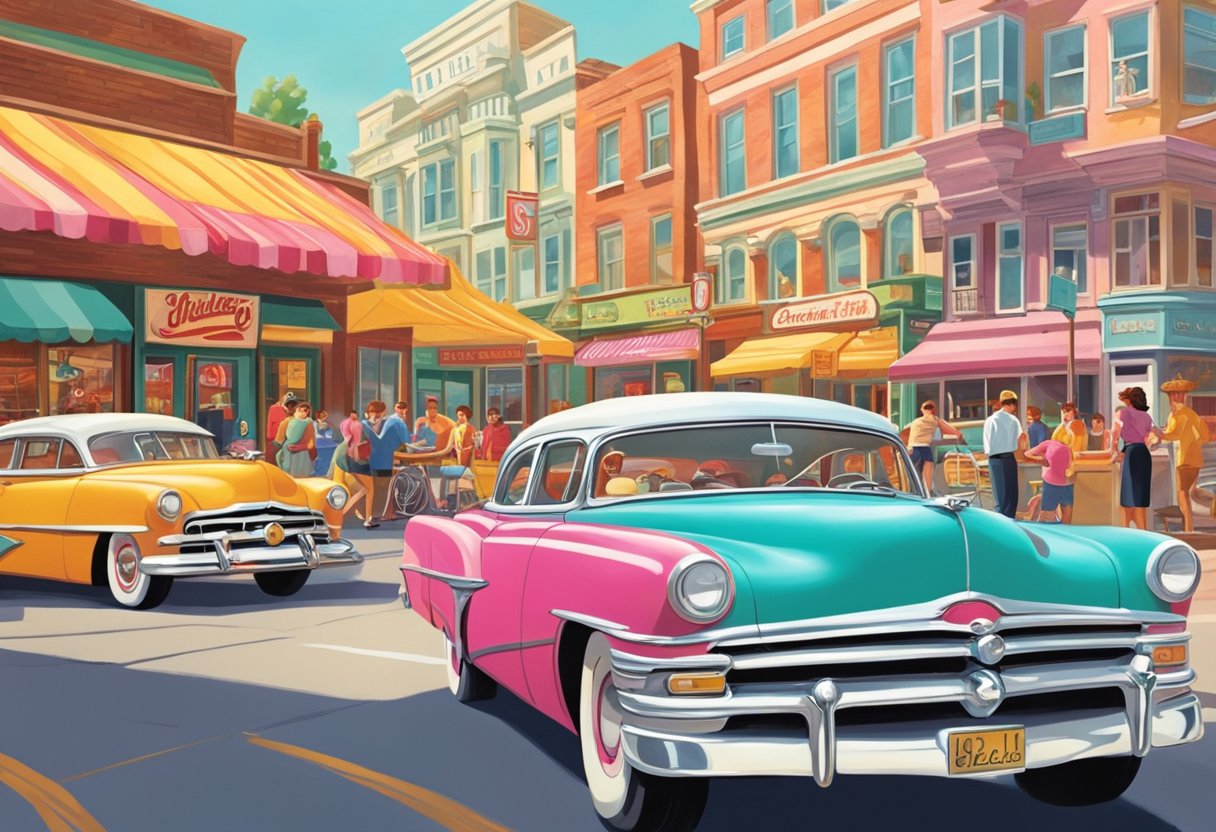
Hot rods, customized cars with modified engines designed for greater speed, became a symbol of American car culture and the freedom it represented, spurring a grassroots movement of vehicle enthusiasts and speed aficionados. Meanwhile, the Hula Hoop encapsulated the essence of a fad that delighted the masses. Marketed by Wham-O in 1958, this hip-swiveling toy became an overnight sensation, selling millions in its first few months, as it whisked children and adults alike into a craze that epitomized the whimsy and innocence of the time.
These fads weren’t mere blips on the cultural radar; they underscored a larger narrative of a dynamic decade marked by youthful energy and the ascendance of American consumerism. People eagerly sought after new and exciting forms of recreation, and the flashy allure of hot rods and the universal appeal of the Hula Hoop affirmed the 1950s as an era where popular culture was profoundly shaped by the thrilling, the novel, and the fun.
The Rise of Hot Rod Culture
The development of hot rod culture represented a unique intersection of American innovation and the passion for speed, as individuals began customizing cars to reflect their personality and to enhance performance.
Origins and Early Adaptors
Hot rod culture has its roots in the 1920s and ’30s, but it was after World War II that it truly accelerated. Service members returning home, equipped with mechanical skills, started tweaking and modifying pre-war cars. They focused on increasing speed and performance, stripping down vehicles for reduced weight and optimizing engines for greater power. These modified cars were often tested on the dry lake beds of California by car enthusiasts eager to push the boundaries of speed.
Influence on 1950s Society
By the 1950s, hot rodding had become more than a hobby—it was a cultural phenomenon. Magazines dedicated to the movement, like Hot Rod Magazine, began to circulate, spreading the gospel of customization and speed. Car enthusiasts emerged as icons influencing fashion, language, and lifestyle. Societal perceptions of the automobile shifted from a mere form of transportation to a symbol of freedom and self-expression. This decade saw hot rods become emblems of rebellion, ingenuity, and craftsmanship within American society.
Hula Hoop: A Global Sensation
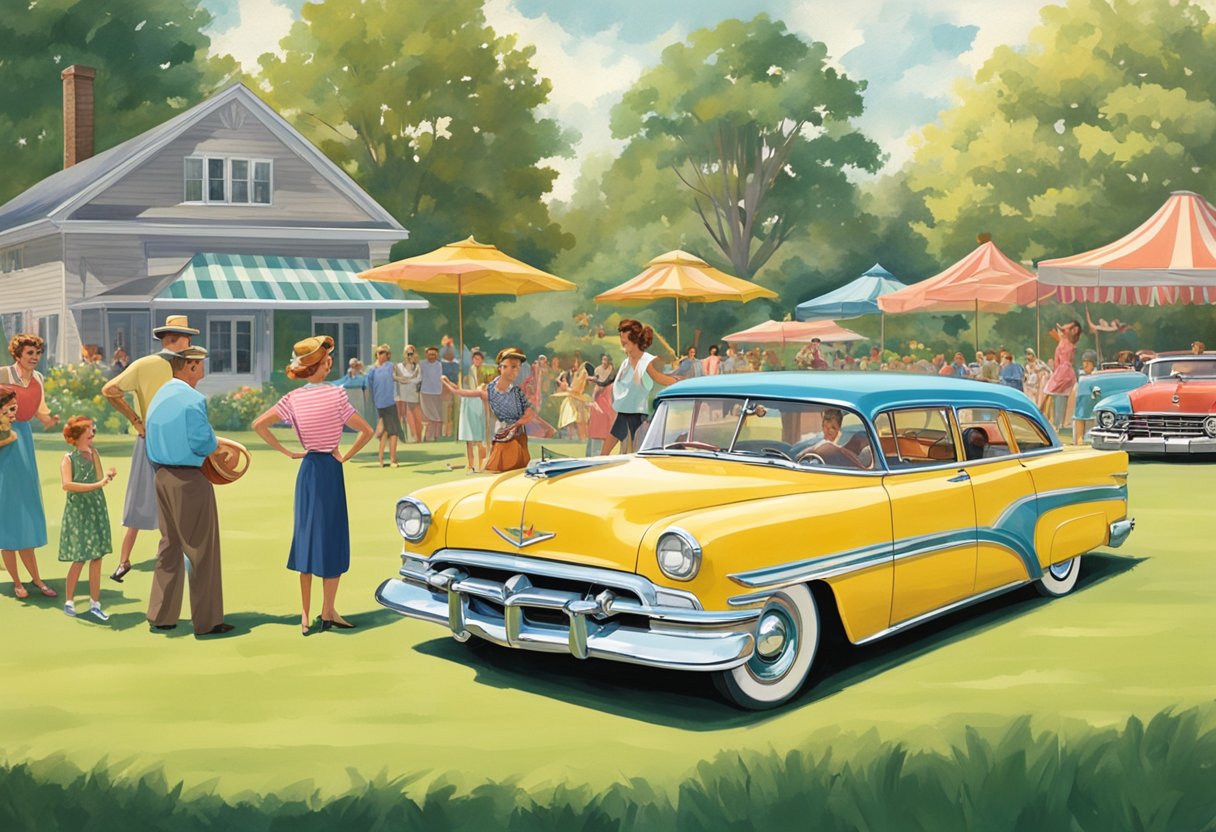
The seemingly simple hula hoop captured the hearts of millions worldwide, evolving from an ancient exercise tool to a 20th-century toy phenomenon and sparking a competitive spirit in contests across the globe.
From Ancient Times to 20th Century
The hula hoop is far from a modern invention. Its history dates back to ancient times, where hoops made from bamboo, wood, or vines were used for both physical exercise and religious rituals. By the 14th century, hooping was popular in England, and later, in the 20th century, the concept traveled to Australia, where hoops fashioned from bamboo gave joy to children.
The Wham-O Revolution
In 1958, the modern hula hoop was reimagined and brought to market by Wham-O, a toy company founded by Richard Knerr and Arthur Melin. Shifting from traditional materials, they introduced hula hoops made of plastic, enhancing durability and flexibility. The name itself, though not directly related to the Hawaiian dance, evoked a sense of fun and exoticism that appealed to a broad audience.
Global Popularity and Contests
The hula hoop craze went viral before “viral” was even a concept. From the coast of California to the streets of Japan, hula hoops encircled the planet, captivating children and adults alike. In countries like Japan and even behind the Iron Curtain in the Soviet Union, people embraced the hoop, spinning it around their waists in a display of physical prowess. The toy became a staple of community competitions, with thrilling hula hoop contests showcasing who could twirl the longest or perform the most impressive tricks.
Marketing Tactics and Media Influence
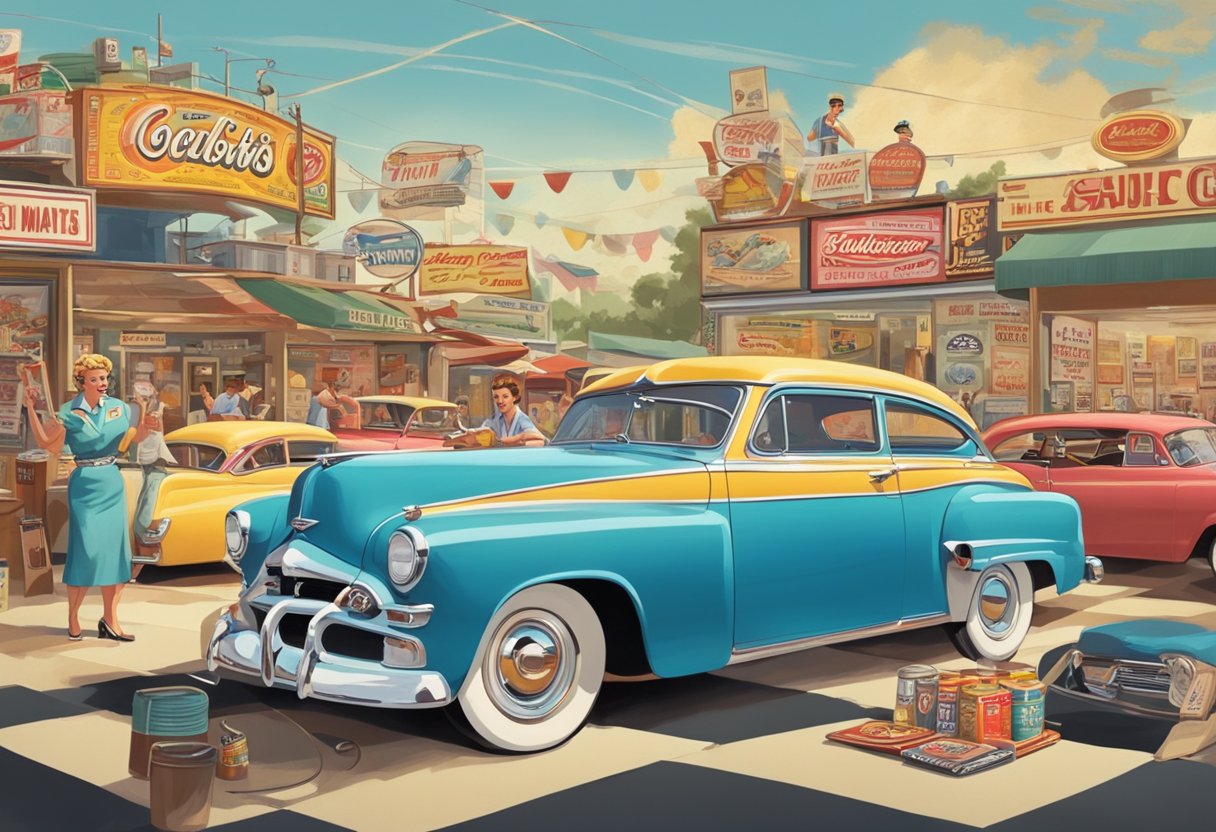
In the 1950s, innovative marketing strategies and the burgeoning reach of new media platforms played pivotal roles in driving the sales of products like hot rods and hula hoops. Clever advertisements and the shift from radio to television broadcasting amplified consumer awareness, ensuring these items became emblematic of the era’s culture.
Role of Advertisement
Advertisements in the 1950s harnessed the power of emotional appeal and aspirational messages to captivate audiences. They often employed bold colors, catchy jingles, and engaging slogans to make lasting impressions. Hot rods, for example, symbolized freedom and rebellion, and ads highlighted these themes to appeal to the youth of the time. With hula hoops, manufacturers touted fun and fitness, turning the simple plastic ring into a national sensation.
From Radio to TV: Spreading the Word
As the decade progressed, television became a household staple, revolutionizing how products were marketed. Sales messages that once traveled through the airwaves of radio found visual storytelling potential on television screens. Shows like I Love Lucy and televised events like the Miss America pageant provided unique platforms for product placements and commercials. The transition also allowed for more dynamic demonstrations of gadgets, like hula hoops in action, making the advertising more compelling and fostering a stronger consumer connection.
Social and Cultural Impact
In the 1950s, a wave of fads and gadgets swept through American life, leaving a lasting imprint on the social fabric and culture, particularly in burgeoning suburbs and the realms of childhood and play.
Fads in American Suburbia
Suburbia became the stage for displaying the newest trends, from hot rods to hula hoops. The suburb was more than just a place to live; it was a community where American families showcased their prosperity and stayed apace with swiftly changing modes of expression. Baby boomers, coming of age during this era, carved out their own distinctive cultural niches, steering the popularity of various pastimes and products.
The garage became a symbol of craft and identity as custom hot rods gleamed in driveways, their shiny exteriors a testament to technology and personal style. These cars were not mere transportation; they represented a labor of love, a hobby that gathered enthusiasts in mutual appreciation.
Impact on Childhood and Play
The ’50s saw children’s play transformed by a deluge of innovative toys. Both American and Australian children took to the simple yet fascinating hula hoop, a plastic ring that promoted active play and became a worldwide sensation. Documented by Owlcation, over 25 million hula hoops were sold in mere months after their release. Toys like these became fixtures in gym classes, encouraging physical activity in a fun, inclusive manner.
Australian children, much like their American counterparts, incorporated these gadgets into their daily activities, showing how fads can bridge cultural gaps. Hula hoops were a ubiquitous presence in neighborhoods, schools, and even became a staple in international youth culture. These toys not only increased engagement in physical play but also fed into the kinetic energy of a generation looking for expression and connectedness through play.
The Decline of Fads
In the 1950s, fads like Hot Rods and Hula Hoops swept through American culture, reaching dizzying heights of popularity before experiencing a decline. This section explores what happens when the novelty wears off and how some items transition into perennial favorites.
The Lifecycle of a Fad
A fad typically emerges when a novel item or activity captures the public’s imagination. Its rise is often rapid, fueled by media attention and word-of-mouth. However, as saturation point is reached, a fad’s popularity begins to wane. This decline can be attributed to market oversaturation, the appearance of newer trends, or simply the fading novelty. Nostalgia may later renew interest, but it seldom restores a fad to its former glory.
- Peak Popularity: The zenith of a fad’s success.
- Decline: When the public begins to lose interest.
- Aftermath: The period when a fad is no longer a mainstay.
Transition to Timeless Classics
Not all fads fade into obscurity; some undergo a transformation. For instance, the Hula Hoop, after its decline, found renewed life as a fitness tool and remains a favorite among those cherishing nostalgia for simpler times. This process of becoming a timeless classic involves gradual integration into the culture, often with a different association than the initial fad.
- Rebranding: Introducing the product to new markets or for new uses.
- Nostalgic Revival: Leveraging the emotional connection of those who grew up with the fad.
Hot Rods, too, have retained a devoted following, as enthusiasts continue to appreciate their craftsmanship and the era they represent. This enduring interest highlights a fad’s potential to weave itself into the cultural fabric and persist beyond its expected lifespan.
Revival and Legacy
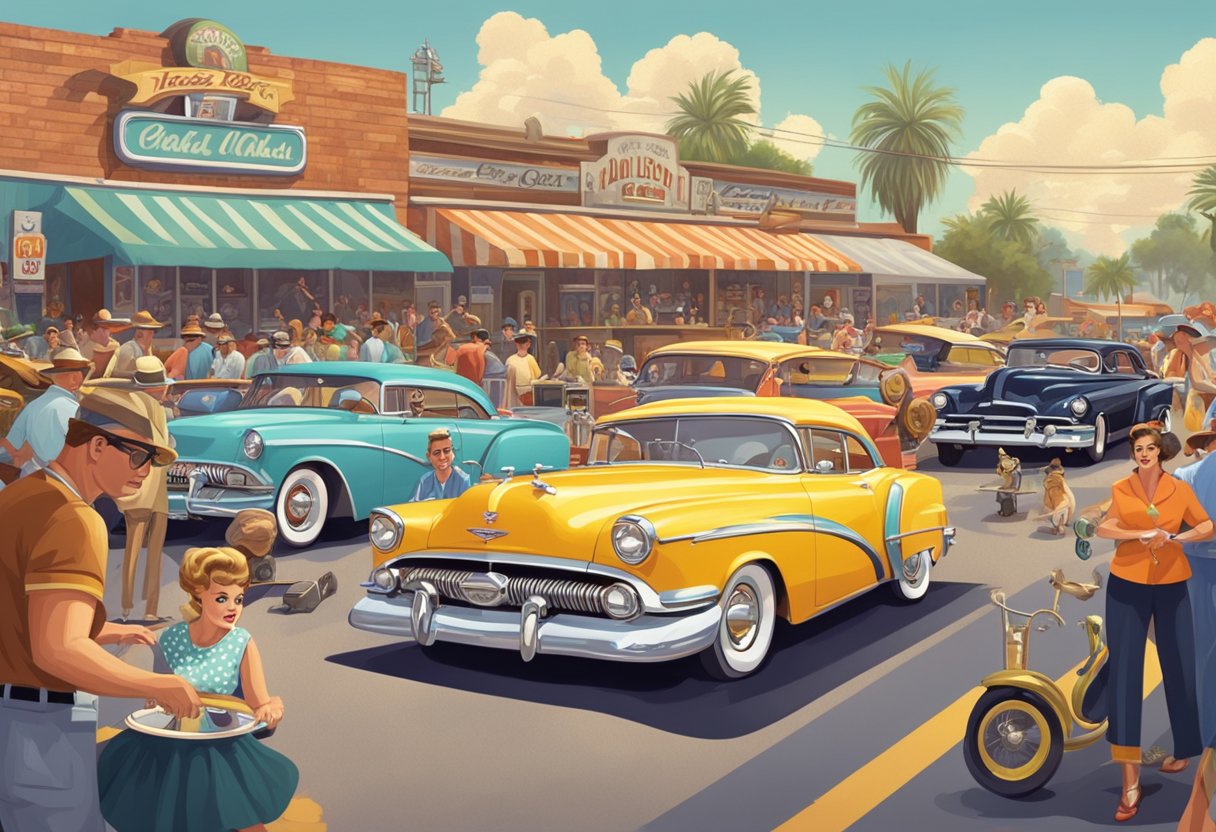
The decades may have passed, but hot rods and plastic hoops continue to stir excitement, often symbolizing the spirit of the 1950s. Their enduring appeal is evident through dedicated collectors and their presence in various cultural expressions today.
Nostalgia and Collectors
Hot rods, with their flashy paint and customized engines, have become prized pieces for enthusiasts who cherish the era’s automotive ingenuity. Conventions and car shows dedicated to these vehicles draw crowds eager to experience a piece of history. Plastic hoops, or more affectionately known as Hula Hoops, have also seen a resurgence as collectible items. Adults who grew up in the ’50s seek out vintage hoops, often for display purposes or to revisit their childhood play.
Incorporation in Modern Culture
advertisements, movies, and music videos often utilize hot rods and Hula Hoops as symbols of freedom and fun. These artifacts of the ’50s now represent more than mere fads; they embody a cultural touchstone that transcends generations. Memorabilia associated with these items, whether they’re miniature models of classic hot rods or retro-inspired plastic hoops, can be found in gift shops and specialty stores, showing that the fad has firmly found its footing in the present.
Manufacturing and Design Evolution
In the 1950s, the production process and materials used for creating hot rods and Hula Hoops underwent significant changes, reflecting a mix of innovation and compliance with emerging safety standards.
Materials and Production
Initially, hot rods were largely made from pre-existing cars, which enthusiasts modified using whatever materials they could find. However, the need for higher performance and aesthetics led to the introduction of custom building materials. Bamboo featured in early Hula Hoops, but it was the development of durable plastic that revolutionized their manufacture. Especially significant was the use of Marlex, a type of plastic created by Phillips Petroleum, which made the Hula Hoop lighter and more flexible.
- Hot Rods:
- Early materials: Scrap parts from older vehicles
- Later evolution: Custom-designed parts, sometimes using newer, lightweight metals
- Hula Hoops:
- Pre-1958: Bamboo and wood
- Post-1958: Marlex plastic, increasing durability and appeal
The Shift to Safety and Regulations
With the rise in popularity of both hot rods and Hula Hoops, concerns about safety began to surface. Manufacturers of hot rods started to focus on how vehicles could be made both faster and safer, resulting in new designs that incorporated safety features without compromising performance. On the Hula Hoop side, as production scaled to meet demand, regulations ensured that the plastic used was safe for all ages, aligning with the consumer protection ethos of the era.
- Hot Rods:
- Design changes: Incorporation of seat belts and roll cages
- Regulatory compliance: Adherence to street legality requirements
- Hula Hoops:
- Safety focus: Non-toxic plastic, smooth edges to prevent injury
- Production oversight: Quality control measures to ensure product consistency
Significance in Modern Times
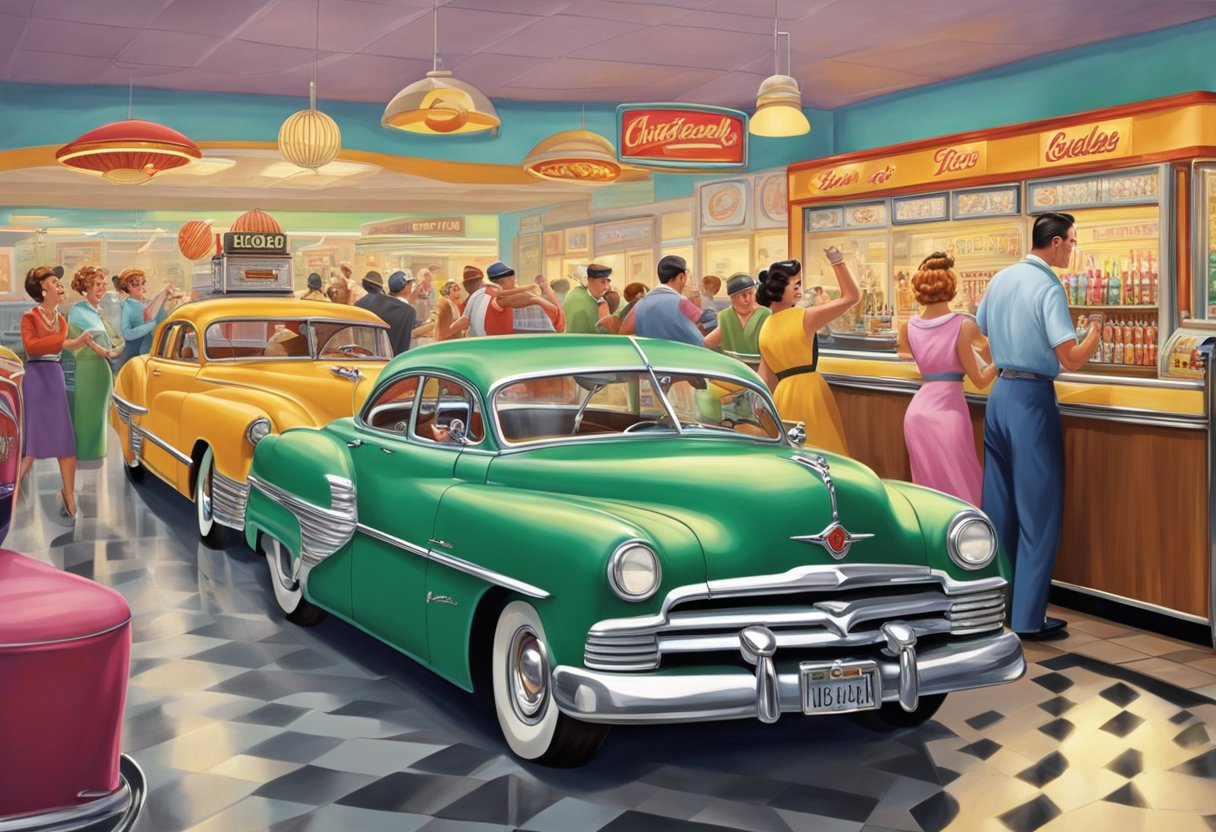
The legacy of hot rods and Hula Hoops from the 1950s continues to be evident in modern culture. Hot rods, once a symbol of rebellion and mechanical ingenuity, have transformed into cherished classics. They are often showcased in car shows and parades, bringing together communities with a shared appreciation for automotive history.
Hula Hoops, as well, have retained their appeal, not merely as a nostalgic toy but also as a tool for exercise and adult fitness programs. Hula Hoop fitness classes attest to the toy’s enduring ability to provide a fun workout. Additionally, the simple hoop has seen a resurgence in popularity through contests and performance art, particularly within the flow arts community.
- Hot Rods:
- Exhibited in car shows
- Restored and collected
- Celebrated in auto clubs
- Hula Hoops:
- Incorporated into workout regimes
- Used in dance and performance art
- Popular across all ages for recreation
Manufacturers have adapted Hula Hoops for modern audiences, producing hoops with added weights for enhanced fitness benefits. The hoops have thus found their way into gyms and wellness centers, appealing to those who seek playful methods to stay active. While the material and design might have evolved, the premise of spinning a hoop for play remains inherently the same, bridging the past with the present and promoting connection across generations.

